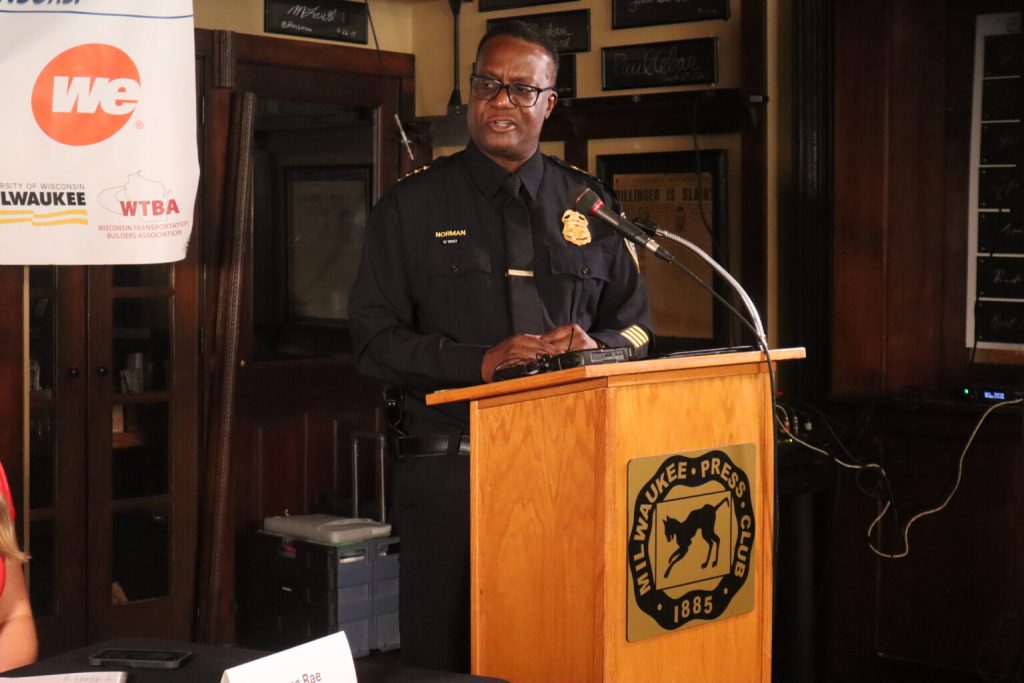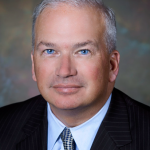Milwaukee Police Chief Faces Tough Questions During Luncheon
Jeffrey Norman talks technology, reckless driving and ACLU settlement with Milwaukee Press Club panel.
“I will say whether I’m glad to be here after the questions,” said Milwaukee Police Department (MPD) Chief Jeffrey Norman in a joking tone on Tuesday morning, during his opening remarks at a Milwaukee Press Club Newsmaker Luncheon. As he spoke, Norman glanced at the media panel, including David Clarey of the Milwaukee Journal Sentinel, Jessica McBride of Wisconsin Right Now and Jenna Rae of TMJ4 News.
As Norman predicted, the panelists proceeded to keep him on the defensive throughout the contentious luncheon. Before he was peppered with questions about safety in downtown Milwaukee, police surveillance and whether officers should return to what courts have ruled were racially discriminatory and unconstitutional stop and frisk practices, Norman presented his own perspective on public safety in Wisconsin’s largest city.
“I always like to start off by saying that I am proud to be the leader of the Milwaukee Police Department,” said Norman, thanking the men and women of MPD “who protect our city through challenging times, through good times, 365 days a year, seven days a week — holidays included.” Norman also thanked the community for supporting MPD after the killing of Officer Kendall Corder, who was shot while responding to a call about a subject with a gun.
Corder was one of at least two officers who have been shot this year. Norman said of the killings that it’s important for MPD officers to feel that “even though we have challenging times, we know that we have a community that’s behind us, and who understands the challenges that we’re going through, in regards to the work of public safety in our community.”
Tremaine Jones (who has pleaded not guilty) was arrested for the slaying with MPD compiling witness statements, and locating a backpack on-scene containing Jones’ social security card, employee I.D., birth certificate, debit cards and a receipt for the lower receiver of the gun police say was used in the shooting. Since 2018, there have been six MPD officers killed in the line of duty.
As Norman moved on to the latest crime statistics, he cautioned that “the numbers are numbers, they’re data sets, but they’re not the reality of what you feel from a personal feeling, your perspective…Never will I ever say that what you feel is not your reality, or the truth. And we have to work to continue to address those concerns.”
Citing the MPD’s mid-year crime statistics report, Norman told the audience at Milwaukee’s Newsroom Pub that there has been:
- A 17% violent crime reduction
- 7% property crime reduction
- 11% reduction overall for serious crimes
“And let me put that in the proper context,” Norman said, “this is on top of reductions in 2024.” According to MPD’s crime statistics dashboard, since this time last year Milwaukee has seen an 18% decline in non-fatal shootings, a 44% decline in car jackings, a 24% decline in robberies, and another 21% decline in aggravated assaults. “Now, the elephant in the room, yes homicides are up,” said Norman. In 2024, there were 132 people who lost their lives to homicide incidents in Milwaukee. A little over half way through 2025, there have been 93.
At the time of the mid-year report, homicides were up 13%, though the most recent numbers on the online dashboard show a 9% increase. “I always say this, anything [more] than zero is unacceptable,” said Norman. The dashboard also shows a 32% increase in human trafficking since last year, and a 52% increase since 2023. Norman didn’t address this increase, and the panelists and audience members didn’t ask about it.
Norman focused on the homicide increase, highlighting what he called “the undercurrent of what these homicides are about” — inter-personal conflict and violence that escalates into harm or death. “Poor conflict resolution,” he said, “availability of firearms to our youth. These are things that we can work together to impact, to intervene, to intercede.”
While MPD is adept at finding high-level offenders in the community, with the department boasting a nearly 80% clearance rate for solving homicides, Norman emphasized that “it’s not enough to have somebody in custody for such a horrible crime. It’s more important to prevent it.”
Collaboration has been a key asset for MPD including working with community groups, elected officials and partnerships with other law enforcement agencies including the Milwaukee County Sheriff’s Office and State Patrol. “When we work together we are better, together, said Norman. “Leaning into the collaboration, leaning into the partnerships truly is where the rubber meets the road, so that we’re able to address when we have a flare-up of crime on Hampton Avenue, or during Cinco de Mayo, or during Juneteenth, or during Water Street, or during the Puerto Rican Fest.” Although Norman said that his own legacy has never motivated his service, he hopes to be remembered as a chief who was there, and who cared, he said, when the Milwaukee Bucks celebrated winning the NBA championship, during the COVID-19 pandemic, the Republican National Convention and the historic floods just days ago. “He was there,” Norman said of himself. “He cared.”
A grilling by the media panel
The first media panel question came from Clarey of the Milwaukee Journal Sentinel about MPD’s use of surveillance technology. The department’s use of facial recognition software, drones and other technologies have raised concerns about privacy and due process.
Norman said that some public safety investigations and interventions have been “wrapped up in a more quick and efficient manner by utilizing the technology.” He mentioned Flock cameras the department uses to monitor license plates and identify vehicles taken in car jackings. He also noted facial recognition technology used in repeat sexual assault and homicide cases. “These are what is going on with this particular technology,” said Norman. “I am very sensitive to the concerns about surveillance, abuse, but I say this, as any tool that can be utilized by law enforcement, has the ability to be abused. It’s about what are the bumper rails? What are the expectations? What is the oversight?”
Norman said his department is committed to oversight and dialogue with the community about the technology. Yet, he also feels that the fears that he’s heard about surveillance technology are often “speculative.” By contrast, the chief said he could describe numerous concrete examples of carjacking suspects and people who committed violent crimes who were apprehended because of the technology. “That is what is going on,” said Norman, “and if there’s any tools that the Milwaukee Police Department can utilize to ensure that there is direct, serious and quick accountability, we shall use it.”
McBride, a journalism lecturer at University of Wisconsin-Milwaukee and contributor to the right-wing website Wisconsin Right Now, asked if Norman would support calling on the city to end its obligations under the Collins settlement, the result of a lawsuit brought by the American Civil Liberties Union (ACLU) of Wisconsin.
McBride said that she’s heard from officers who feel that the agreement, which mandated changes to MPD’s practices, has made it “difficult if not impossible” to do “proactive policing.” She cited a decline in “field interviews,” or officers talking to and gathering information from people, as well as traffic stops. She connected those changes to the rise of reckless driving in Milwaukee. Norman said that officials have focused on checks and balances to ensure that MPD is compliant, but that he also agrees that the Collins settlement should be “heavily modified.”
The agreement carries “a number of administrative burdens,” Norman said, stressing that he wholly supports constitutional policing. “There is really no wiggle room,” said Norman. “At the end of a shift, reports need to be filed. Some of our officers have done two shifts. They’re tired…There’s a cost associated with this, that’s overtime being used.” Norman said that MPD no longer sees the sort of constitutional violations which led to the Collins settlement, and that the department has shown itself to be responsible, and that things will never “backslide” on his watch.
Rae of TMJ4 asked about an incident involving a car that crashed through a police barrier in downtown Milwaukee, severely injuring two women who were crossing the street. She pushed Norman to explain why “no detectives interviewed the victims or any of the bystanders to follow up on the investigation after that crash?”
Norman said that the investigation went as far as it needed to go, and that it culminated in “accountability measures,” which included issuing citations. Rae, unsatisfied, pushed back saying Norman didn’t answer her question, but the chief reiterated that officers were on scene, interviews were done, and that nothing more was required. An awkward silence followed as the microphone passed back to Clarey, who asked about Norman’s support of city ordinances related to so-called “street takeovers”, where people noisily gather in intersections and do tricks with their cars. Later, Rae pressed Norman further on the car crash. He said he was unprepared to focus on the specific details she wanted him to discuss.
McBride asked Norman about his $65,000 raise, bringing his salary to $243,000, and added that MPD officers have gone without a raise for over two years. She asked Norman why he accepted the raise, whether he’d suspend his raise until other MPD officers receive one, and whether he supports officers getting back-pay from the city. Norman said that he earned his raise not only through his credentials, which include a law degree, but also through the amount of hours he puts in as chief.
“I sometimes work maybe 12-14 hours, work Saturdays and Sundays, I’m actually really never off,” said Norman. “It is important to understand that no one has given me anything for free, the work that I do is earned.” In 2022, CBS58 reported that over a dozen officers made more money than the chief due to overtime pay.
Norman said he supports contract negotiations that could include back pay for officers, and that the process is in the hands of the Milwaukee Police Association and the mayor. McBride pressed again about how his raise hurts officer morale and whether he supports officers getting back pay.
The chief was also asked about officers being sent away from their own districts to work downtown and whether “broken windows” policing — a strategy that favors tight control of even small infractions to create an overall climate of safety — should be brought back. McBride suggested he did not have “an articulable policing strategy.”
Norman was asked how he defines reckless driving; how a driver could crash into people after driving through a police barrier and “not see a day in court”; why reckless drivers without insurance retain their vehicles; how MPD retains recruits; whether prosecutors and judges should mete out tougher charges and penalties; how the Black Lives Matter protests and media reporting of policing hurts the profession and how MPD has achieved declines in carjackings. He expressed disappointment that reporters were focusing on certain incidents rather than others — including a deceased 13-year-old who wasn’t claimed for over a week, another 13-year-old who shot and killed people with an extended magazine firearm and crime on the South Side. Norman said in those cases “I wish you had the type of reporting as you have right now.”
Norman responded to a question from Wisconsin Examiner about inter-personal violence in the community and whether arresting more people and bringing more serious charges is the most effective strategy.
“When you’re talking about inter-personal conflict, how or why does it rise [to] a level of firearm violence is perplexing,” he said. “The other day we had a situation where a person was inappropriately touched. She sees the individual who inappropriately touched her, wants to confront that person, and [in] that particular confrontation someone dies, because a firearm was used.” It would have been better to call the police than to try to resolve things with a firearm, he said.
Therapists and social scientists might have better answers to questions about violent behavior, he said. But, he added, he is committed to strengthening community partnerships with public health and safety teams, mental health specialists and other non-law-enforcement experts to try to resolve conflicts before they become violent. Many situations that escalate into homicides and firearm violence are “emotional,” he said. MPD embraces violence intervention and encourages people to be more introspective instead of “going zero to 90.”
“I do know that we’re not going to be able to arrest our way out of this,” Norman said of social conflict that can turn violent. Solving Milwaukee’s homicide cases is important but, he said, the community should ask, “How do we prevent it from happening, to where we don’t even have those numbers? That’s the real question.”
Milwaukee Police Chief Norman parries questioning during tense press club luncheon was originally published by the Wisconsin Examiner.
If you think stories like this are important, become a member of Urban Milwaukee and help support real, independent journalism. Plus you get some cool added benefits.






















Don’t we all wish we could receive a 30% raise and contract extension? We already know he’s been looking elsewhere, so is he really committed to this city?
Our police officers deserve a settled contract. And it should include hiring more civilian positions to handle desk, data, and customer service.
And, now that the full horrific video & other details of the “accident” with the seriously injured young ladies on Water Street has been released, I’m convinced more than ever that a more thorough investigation and arrest was in order.